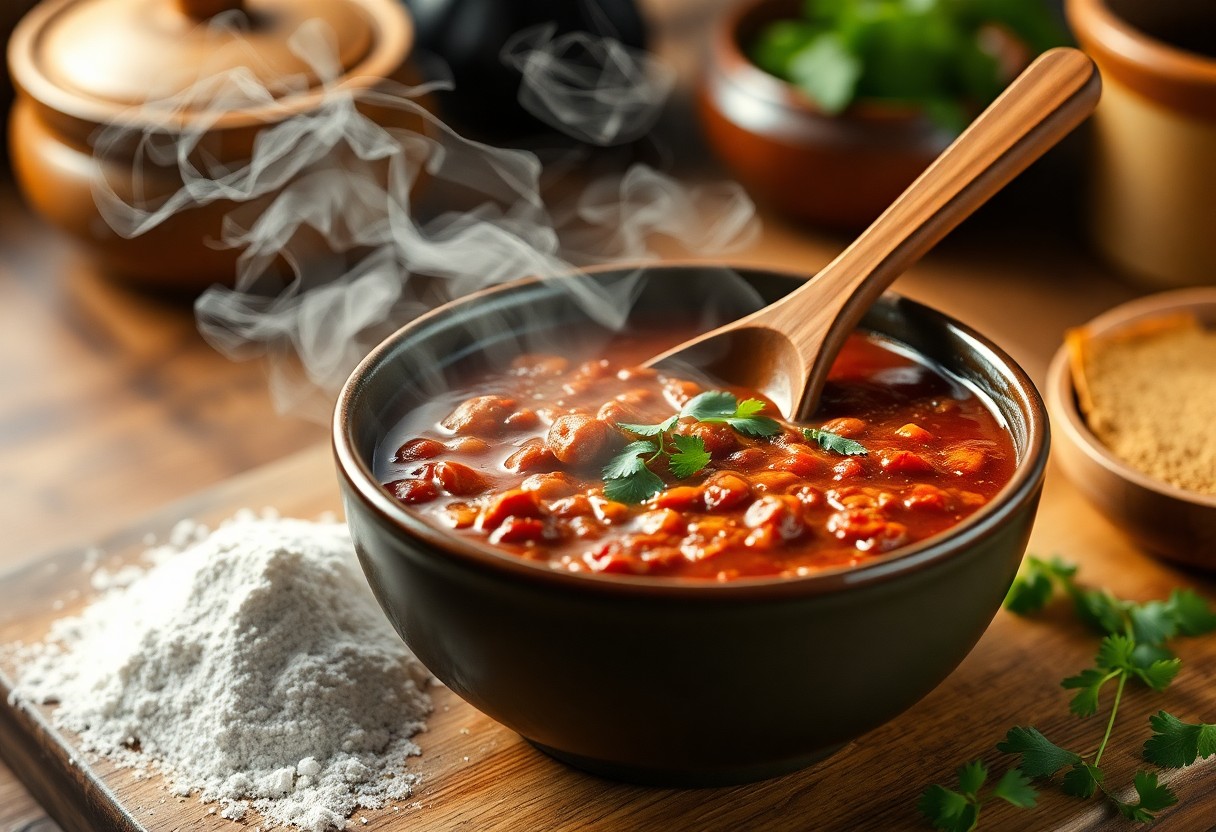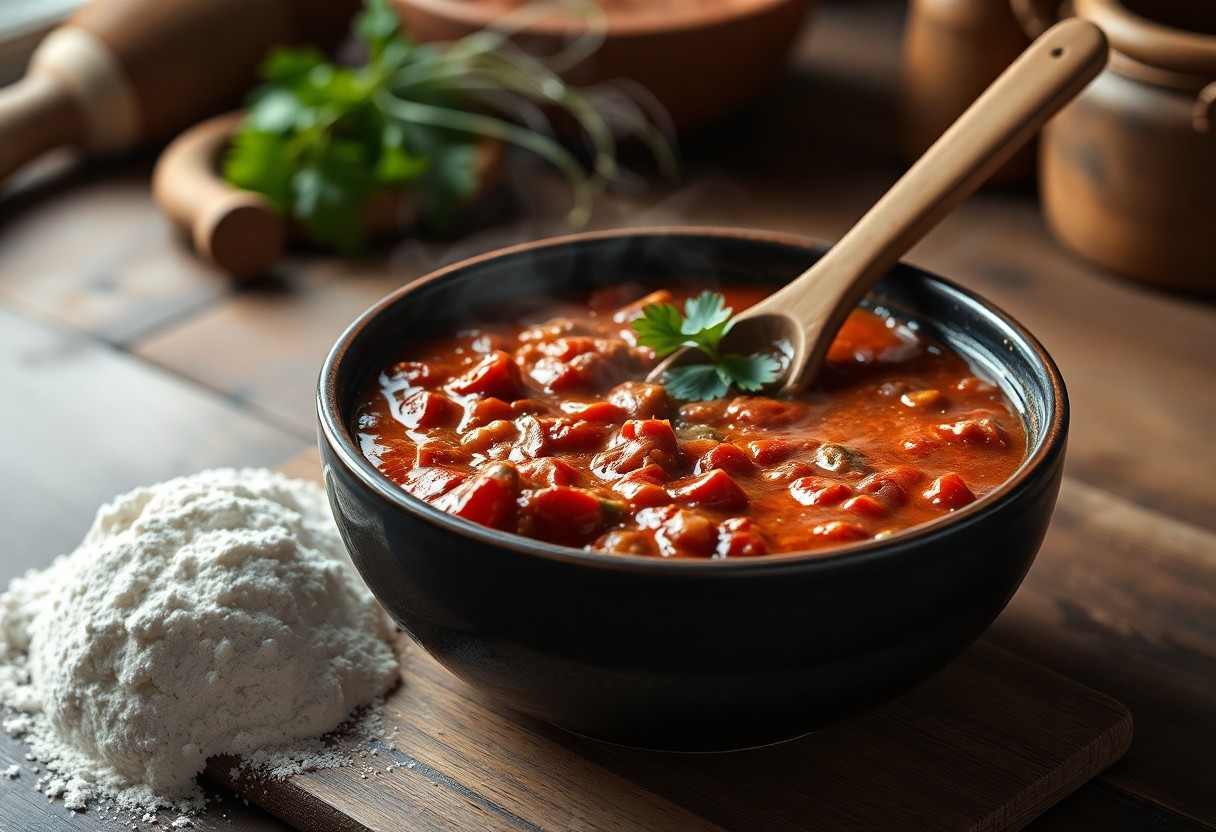Just when you think your chili is perfect, you might find it needs a little more body for that hearty satisfaction. If you want to achieve a thicker consistency, using flour can be a simple and effective solution. In this guide, you’ll explore various easy hacks to help you incorporate flour into your chili without clumping, ensuring that your dish maintains a delicious flavor and inviting texture. Let’s examine how to elevate your chili game and create a meal that warms both the heart and the soul.

Key Takeaways:
- To thicken chili with flour, create a slurry by mixing equal parts flour and cold water, then stir it into the chili gradually to avoid clumps.
- Another method is to sprinkle flour directly into the chili while stirring continuously, allowing it to cook and thicken the dish evenly.
- For best results, use a small amount of flour at first, as you can always add more if needed to achieve your desired thickness.

Understanding Chili Consistency
Your chili’s consistency is imperative for creating a satisfying bowl that keeps you warm and full. A well-balanced texture can elevate your dish from simple stew to a delightful meal. Whether you enjoy a thicker, chunkier chili or prefer a smoother, broth-like experience, understanding the elements that contribute to consistency is key to perfecting your chili game.
Importance of Thickness
Against popular belief, thickness isn’t just about appearance—it impacts how flavors meld and how ingredients interact. A hearty chili with the right thickness holds onto spices better, resulting in a more flavorful dish. Additionally, a thicker chili provides a satisfying mouthfeel, making each bite enjoyable.
Factors Affecting Chili Texture
One of the primary factors impacting your chili’s texture is the choice of ingredients. Key components include:
- Beans
- Meat
- Vegetables
- Liquids
- Cooking Time
Knowing how these factors interplay will help you achieve the desired consistency for your chili.
Chili texture can change dramatically based on various elements. The type of beans you select can either absorb liquid or add density. Likewise, the meats you include can break down over time or remain firm. Adding vegetables affects not just flavor but also thickness. Pay attention to how much liquid you use, as too much can lead to a watery mix. Finally, cooking time determines how ingredients break down and combine. Knowing these factors can guide you in crafting your perfect bowl of chili.
Using Flour as a Thickening Agent
Any time you find your chili lacking the desired thickness, using flour can be an effective solution. This versatile ingredient acts as a natural thickener, enhancing both the texture and flavor of your dish. Simply mix it with a bit of water or broth to create a slurry before adding it to your simmering chili. This technique ensures a balanced consistency without clumps, making for a heartier bowl that you and your guests will appreciate.
Types of Flour Suitable for Chili
Along with all-purpose flour, you can consider using different types that can elevate your chili’s richness:
| All-Purpose Flour | Common and versatile for thickening. |
| Cornstarch | Gluten-free option, blend with water. |
| Whole Wheat Flour | Adds more nutrients and a slightly nutty flavor. |
| Rice Flour | Great for gluten-free thickening. |
| Oat Flour | Offers a unique taste and healthy options. |
Perceiving the wide range of flours available, you can tailor your chili to your dietary preferences while achieving the desired thickness.
How Flour Works in Cooking
One of the many benefits of using flour in cooking is its ability to absorb moisture and swell, creating a thicker consistency. When heated, the starches in the flour gelatinize, binding together and helping to thicken your chili. This process not only improves texture but also enhances the overall flavor, making your dish more satisfying.
Plus, understanding how flour works fundamentally changes your approach to cooking. It’s crucial to use it correctly to avoid a *lumpy texture* or *over-thickening*, which can detract from your chili’s flavor. Achieving a *smooth, well-integrated* blend is key, so always mix flour with some liquid before adding it to hot liquids. This technique ensures that your chili remains consistently delicious and enjoyable, elevating your dish to the next level for you and your guests.
Step-by-Step Guide to Thickening Chili
Not all chili is created equal; sometimes, you need to thicken it for a heartier meal. Here’s a simple guide to help you achieve that desirable thickness using flour:
| Step | Description |
|---|---|
| 1 | Gather your ingredients. |
| 2 | Prepare the flour mixture. |
| 3 | Incorporate the flour into the chili. |
| 4 | Simmer until thicken. |
Preparing the Flour Mixture
Below, you’ll need to create a smooth flour mixture to ensure no lumps form in your chili. Combine equal parts flour and cold water in a bowl. Whisk until you have a smooth consistency, resembling a slurry. This step is paramount as it prevents clumping once added to your simmering chili.
Incorporating Flour into Chili
About halfway through your cooking process, it’s time to add the flour mixture. Slowly pour it into your bubbling chili while stirring continuously to maintain an even texture.
Chili can thicken just right when you add this flour slurry. Be cautious not to add too much at once; it can lead to an overly dense texture. Stir well and allow it to simmer for several minutes. This will help the flour blend in seamlessly and achieve that rich, thickened consistency you desire, enhancing the enjoyment of your chili.
Alternative Thickening Methods
For those looking to enhance the texture of their chili without using flour, there are several alternative methods at your disposal. You can experiment with different thickening agents like cornstarch, masa harina, or even legumes to achieve the desired consistency. Each option adds its own unique flavor and thickness, allowing you to customize your dish while maintaining its heartiness.
Other Ingredients to Consider
The addition of ingredients such as potatoes or pumpkin puree can significantly contribute to thickening your chili. These options not only help thicken the sauce but also provide extra nutrition and a subtle sweetness, enhancing the overall flavor profile without the need for flour.
Techniques without Flour
An effective technique to thicken chili without flour involves pureeing a portion of your cooked beans or vegetables. By blending some of the mixture and stirring it back in, you create a thicker texture while preserving the hearty chunks of ingredients you love.
Ingredients like cornstarch or arrowroot powder also serve as excellent alternatives for thickening your chili without flour. To use these, combine them with a small amount of water to create a slurry, then stir it into your chili and let it cook until thickened. Alternatively, consider adding puréed vegetables or cooked lentils to boost thickness naturally. All these methods provide excellent thickness and texture while ensuring your chili remains delicious and satisfying.

Common Mistakes to Avoid
Many home cooks encounter pitfalls when thickening chili with flour. One common mistake is not giving the flour enough time to cook, leading to a raw taste. You should also avoid adding flour too quickly or in clumps, as this can create an undesirable texture. Lastly, not adjusting your liquid content accordingly can result in a soupy chili despite your best thickening efforts. Keep these pointers in mind to ensure your chili reaches that perfect hearty consistency.
Over-Thickening the Chili
Above all, be cautious when thickening your chili. Adding too much flour can lead to a paste-like consistency that detracts from the dish. Instead of achieving a rich, hearty chili, you might end up with something unappetizing and off-putting. Measure carefully and adjust gradually to prevent this common misstep.
Using the Wrong Flour
Among the various types of flour you can use, choosing the wrong one can hinder your chili’s texture and flavor. Each type of flour behaves differently when cooked; for example, whole wheat flour can impart a gritty texture and a strong taste, while almond or coconut flour might not thicken well at all. It’s necessary to select all-purpose flour or a gluten-free alternative to achieve the right balance and consistency that complements your chili. This choice ensures you get that satisfying heartiness while maintaining an inviting flavor profile.
Also, note that the absorption properties of different flours vary. For instance, cornstarch can thicken liquids without affecting flavor significantly, while self-rising flour can add an unwanted leavening effect. Choosing the appropriate flour can make a significant difference in both the outcome of your chili and your overall cooking experience. Make informed decisions to create a delicious, hearty bowl every time!
Tips for the Perfect Chili
All aspiring chili makers should focus on a few key elements to achieve a delicious, hearty dish. Consider these tips for your next batch:
- Use a variety of meats for added flavor and texture.
- Select fresh spices over pre-packaged mixes.
- Incorporate beans for protein and richness.
- Utilize fresh vegetables for a well-rounded taste.
- Don’t rush the cooking process; let it simmer low and slow.
Assume that by following these guidelines, your chili will stand out and satisfy any palate.
Balancing Flavors with Thickness
Behind every hearty bowl of chili is a perfect balance of flavors and thickness. Too much flour can lead to a paste-like consistency, whereas too little can make your dish watery. The key is to gradually incorporate flour while tasting and adjusting accordingly to achieve that ideal texture and depth of flavor.
Adjusting Consistency to Personal Preference
Along your chili-making journey, you’ll want to tailor the consistency to meet your taste. Whether you prefer a thick, stew-like chili or a soupier version, the amount of flour you add will play a significant role. You can start with a tablespoon and gradually increase it, ensuring it blends well without clumping, allowing you to achieve your desired outcome.
Personal preferences will greatly influence how you adjust consistency in your chili. You might add a little extra flour or even a splash of broth to fine-tune your chili’s texture. Be aware that your choice can significantly impact the final dish—too much flour creates a heavy feel, while too little may leave you with a thin and unsatisfying texture. Ultimately, the goal is to find the balance that enhances your chili experience, ensuring it’s both satisfying and flavorful.
Summing up
Conclusively, thickening your chili with flour is a straightforward process that can enhance the texture of your dish. By creating a slurry or adding it directly to your pot, you can achieve the heartiness you’re looking for. This not only improves the overall consistency but also elevates the flavors, making your chili more satisfying. With these easy hacks in mind, you can confidently experiment with your chili recipe and enjoy a deliciously thick bowl every time.
FAQ
Q: Why would I want to thicken my chili with flour?
A: Thickening chili with flour can enhance its texture and body, making for a heartier and more satisfying meal. A thicker chili clings better to ingredients like rice or cornbread, and it can help balance strong flavors, making the dish feel more cohesive. Additionally, a thicker chili can be more visually appealing and comforting, especially during colder months.
Q: How do I properly incorporate flour into my chili?
A: To incorporate flour into your chili, it’s best to create a slurry. Mix equal parts flour and cold water in a small bowl until smooth. Gradually stir the slurry into your simmering chili. Allow it to cook for a while, at least 10-15 minutes, to let the flour cook fully and thicken the chili properly. This method prevents lumps and ensures an even consistency throughout your dish.
Q: Can I use whole wheat flour instead of all-purpose flour to thicken my chili?
A: Yes, you can use whole wheat flour to thicken chili. However, keep in mind that it may impart a slightly different flavor and darker color compared to all-purpose flour. The thickening power is similar, but you might notice a denser texture. If you’re looking for a healthier option or a richer taste, whole wheat flour can be a great choice.
Q: What if I don’t have flour on hand? Are there alternatives for thickening chili?
A: If you don’t have flour, there are several alternatives you can use. Cornstarch or arrowroot powder can be used as thickeners in a slurry, acting similarly to flour. You can also use masa harina, a corn flour commonly used for tortillas, which adds a unique flavor. Additionally, pureeing a portion of the chili, or adding beans and lentils, can naturally thicken the dish while enhancing its nutritional value.
Q: How much flour should I use to thicken my chili?
A: The amount of flour you should use depends on how thick you want your chili to be and the total volume of your dish. A general guideline is to start with 1-2 tablespoons of flour per quart of chili. Always start with a smaller amount, as you can always add more, but it’s difficult to reverse if you over-thicken. After adding the initial flour, allow the chili to simmer for a bit before assessing the thickness and adjusting as necessary.
